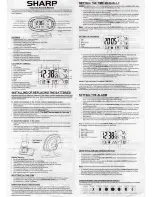
DS3232
The DS3232 can operate in the following two modes:
Slave receiver mode (DS3232 write mode):
Serial
data and clock are received through SDA and SCL.
After each byte is received, an acknowledge bit is
transmitted. START and STOP conditions are recog-
nized as the beginning and end of a serial transfer.
Address recognition is performed by hardware after
reception of the slave address and direction bit. The
slave address byte is the first byte received after the
master generates the START condition. The slave
address byte contains the 7-bit DS3232 address,
which is 1101000, followed by the direction bit (R/
W
),
which is 0 for a write. After receiving and decoding
the slave address byte, the DS3232 outputs an
acknowledge on SDA. After the DS3232 acknowl-
edges the slave a write bit, the master
transmits a word address to the DS3232. This sets
the register pointer on the DS3232, with the DS3232
acknowledging the transfer. The master may then
transmit zero or more bytes of data, with the DS3232
acknowledging each byte received. The register
pointer increments after each data byte is trans-
ferred. The master generates a STOP condition to
terminate the data write.
Slave transmitter mode (DS3232 read mode):
The
first byte is received and handled as in the slave
receiver mode. However, in this mode, the direction
bit indicates that the transfer direction is reversed.
Serial data is transmitted on SDA by the DS3232
while the serial clock is input on SCL. START and
STOP conditions are recognized as the beginning
and end of a serial transfer. Address recognition is
performed by hardware after reception of the slave
address and direction bit. The slave address byte is
the first byte received after the master generates a
START condition. The slave address byte contains
the 7-bit DS3232 address, which is 1101000, fol-
lowed by the direction bit (R/
W
), which is 1 for a
read. After receiving and decoding the slave
address byte, the DS3232 outputs an acknowledge
on SDA. The DS3232 then begins to transmit data
starting with the register address pointed to by the
register pointer. If the register pointer is not written to
before the initiation of a read mode, the first address
that is read is the last one stored in the register point-
er. The DS3232 must receive a not acknowledge to
end a read.
Handling, PC Board Layout,
and Assembly
The DS3232 package contains a quartz tuning-fork
crystal. Pick-and-place equipment can be used, but
precautions should be taken to ensure that excessive
shocks are avoided. Exposure to reflow is limited to 2
times maximum. Ultrasonic cleaning should be avoided
to prevent damage to the crystal.
Avoid running signal traces under the package, unless
a ground plane is placed between the package and the
signal line. All N.C. (no connect) pins must be connect-
ed to ground.
Chip Information
SUBSTRATE CONNECTED TO GROUND
PROCESS: CMOS
Package Information
For the latest package outline information and land patterns,
go to
www.maxim-ic.com/packages
. Note that a “+”, “#”, or
“-” in the package code indicates RoHS status only. Package
drawings may show a different suffix character, but the drawing
pertains to the package regardless of RoHS status.
Extremely Accurate I
2
C RTC with
Integrated Crystal and SRAM
18
____________________________________________________________________
PACKAGE
TYPE
PACKAGE
CODE
OUTLINE
NO.
LAND
PATTERN NO.
20 SO
W20#H2


































